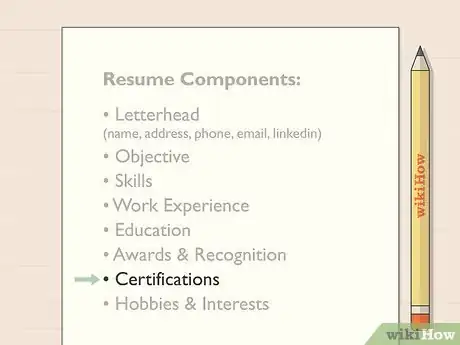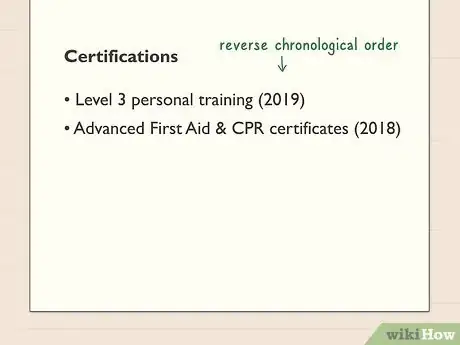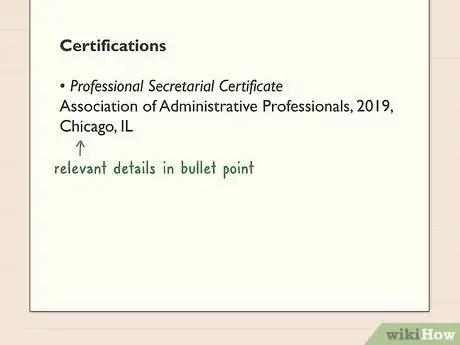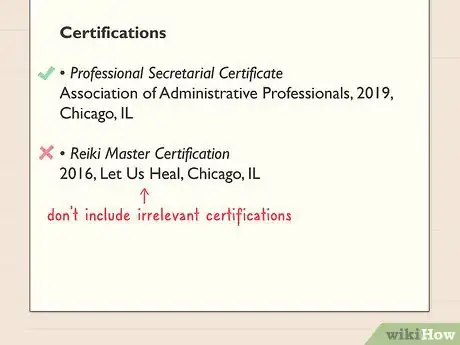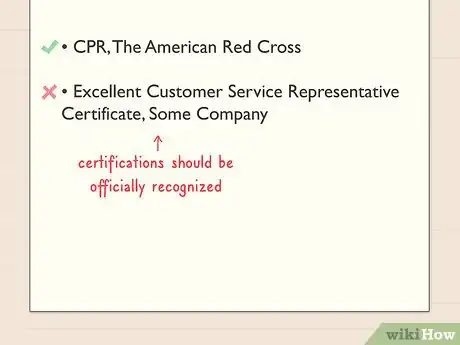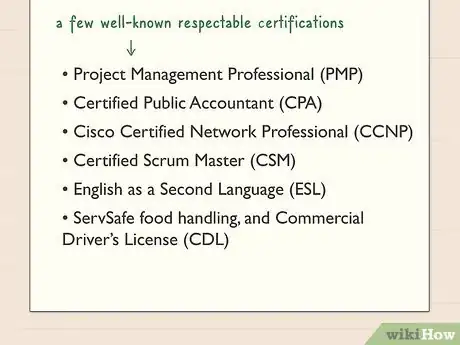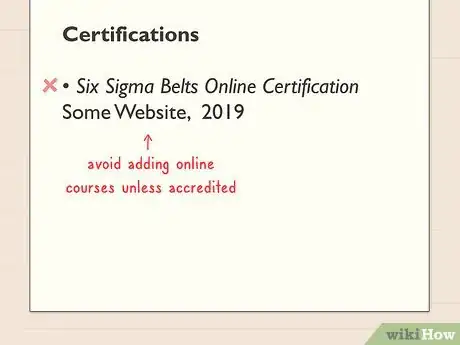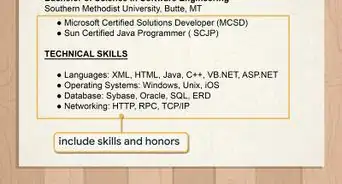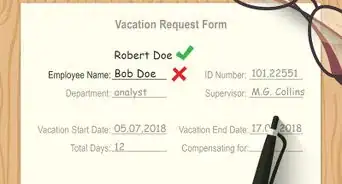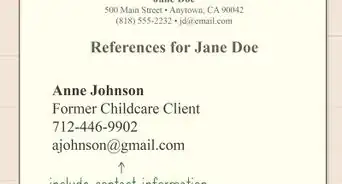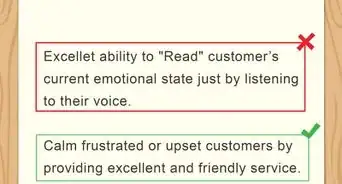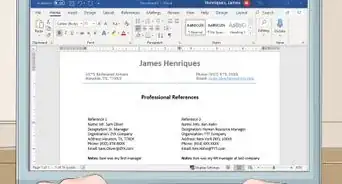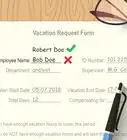This article was co-authored by Katrina Georgiou. Katrina Georgiou is a career coach and the founder of Katrina Georgiou Coaching based in Silicon Valley. Katrina helps individuals find new careers as well as career advancement, including resume writing, interview preparation, salary negotiation, and performance reviews. Trained in the co-active method from the Coaches Training Institute (CTI), Katrina uses personalized communication and leadership strategies to support her clients in building successful and fulfilling careers.
There are 8 references cited in this article, which can be found at the bottom of the page.
This article has been viewed 29,490 times.
Certifications of various kinds can make an attractive addition to any resume. If you really want to make an impression, however, it’s important to know how to format them in a way that highlights them as relevant examples of specialized knowledge and experience. It’s a good idea to only include certifications that have something to do directly with the position you’re applying for. Once you’ve decided which certifications fit the bill, list them in their own section at the bottom or sidebar of your resume, condensing all the important details into 1-2 bullet-pointed lines for maximum readability.
Steps
Formatting Your Certifications on Your Resume
-
1Give your certifications their own section of your resume. Rather than trying to cram your certifications in with your work or education history, tack on a whole new section titled “Certifications” where you can list them separately. That way, they’ll all be neatly organized in one place, so your employer won’t have to go hunting for them or be forced to pick them out of a jumble of other qualifications.
- Situate your Certifications section near the bottom of your resume after your more important sections. Alternatively, you can place it off on its own in a sidebar.
Tip: The only exception to this guideline is if the certification is essential to the performance of your job, such as a nursing or CPA license, in which case you should display it next to your name in your header, or in whichever main section it fits best.[1]
-
2List your certifications in reverse chronological order. Head off your new section with the certification you were awarded most recently, then work your way down to your most dated distinction. Prospective employers will want to see your most up-to-date credentials first.[2]
- This is the same order in which your work history and education will be displayed on your resume. When in doubt, go from newest to oldest.
Advertisement -
3Provide all relevant details about the certification in 1-2 bullet-pointed lines. Write out the full title of the certification first, followed by the name of the certifying authority, the date it was awarded, and finally the location, if applicable. Separate each item with a comma, and make sure all the information you include can fit on no more than a couple of lines.[3]
- Each line in your Certifications section should look something like this: •Professional Secretarial Certificate, Association of Administrative Professionals, 2014, Chicago, IL[4]
- Don’t abbreviate the title of your certification (like using “PMP” in place of “Project Management Professional”) unless you’ve already spelled it out in full. After that, it’s okay to use the shortened form.
- The location designation really only matters for state-specific certifications, such as nursing and teaching licenses.
-
4Mention less important certifications in your cover letter. If you’ve racked up any certifications over the years that are non-vital or only loosely related to your position, consider noting them in the description of yourself that you write to accompany your resume. This will allow you to provide further examples of the steps you’ve taken to advance your career without seeming like you’re desperate to fill up space.[5]
- If you once took a training course on web-based public relations or corporate stress management techniques, you might refer to the experience when going over the details of your academic or professional journey.
Including the Right Certifications
-
1List certifications that are relevant to your professional experience. As a general rule, it’s best to put a particular certification on your resume if and only if it has some connection to the job you’re applying for.[6] A chartered financial consultant certificate, for example, is more likely to impress the hiring coordinator for a finance firm then a weekend scuba diving or long-distance reiki master certification.[7]
- Any certifications you mention that don’t have any relation to your current career path will just take up valuable space that you could be using to showcase more important achievements.
- This doesn’t mean that the miscellaneous certifications you’ve collected over the years are useless. It just means that you'll be better served by saving them for an updated resume for a job in a related field.
Tip: A longer certification list isn’t always better. When it comes to credentials, most employers are looking for quality, not quantity.
-
2Make sure the certifications you include are officially recognized. Not all certifications are made equal. Official certifications are always issued and authorized by an accredited organization, such as a professional association or academic institution. Since anyone can hand out an unofficial certification, they’re not worth much from a professional standpoint.[8]
- Before you go out for a certain certification, check to see whether the organization granting it carries a seal of accreditation from a higher certifying body. This information will often be displayed loud and proud on the organization’s website or internal literature.
- Similarly, special training courses can help round out a detailed resume, provided they were conducted by an accredited institution and resulted in an official certification.
-
3Feel free to put academic certificates in your Certifications section. If you happen to hold a pre-degree certificate in a subject related to your chosen field, your resume is a good place to flaunt it. Earning an academic certificate shows that you’ve completed a certain amount of high-level education and testing, which is exactly what certifications are meant to do.[9]
- Remember to reserve the Education section of your resume for more exemplary academic achievements like undergraduate and postgraduate degrees.
-
4Look into the types of certifications that are most attractive to employers. Even if you have a slew of official certifications, some may be more enticing to your future boss than others. Certifications issued by notable national agencies like OSHA, FEMA, and the American Red Cross tend to draw the most positive attention from hiring directors. If you have the time, money, and motivation, beefing up your resume with a couple of high-profile certifications could potentially boost your career.[10]
- Every industry has its own coveted certifications. Do a little research to find out which credentials are most highly regarded your field.
- Examples of a few well-known, respectable certifications that could help you scale the corporate ladder include Project Management Professional (PMP), Certified Public Accountant (CPA), Cisco Certified Network Professional (CCNP), Certified Scrum Master (CSM), English as a Second Language (ESL), ServSafe food handling, and Commercial Driver’s License (CDL).[11]
-
5Avoid adding online courses unless they resulted in an official certification. Online courses are a major gray area in resume writing. A good way to determine whether or not to list a given course is to consider what awaits you at the end. If it’s a widely-recognized certificate or license from an accredited organization, go ahead and include it. If it’s some sort of unofficial certificate or simply a better understanding of a niche field, it’s probably not worthy of inclusion.[12]
- The term “online course” can basically mean anything—there are online courses in hypnosis, animal telepathy, virtual terraforming, and web-based pickup artistry. Needless to say, none of these subjects make for good resume material.[13]
References
- ↑ https://medicine.umich.edu/sites/default/files/content/downloads/Williams-CV-1114.pdf
- ↑ https://www.socialwork.org/resources/resume-guide/
- ↑ https://www.socialwork.org/resources/resume-guide/
- ↑ https://academicguides.waldenu.edu/careerservices/cvguide/licenses
- ↑ https://fairygodboss.com/career-topics/certifications-on-a-resume
- ↑ Katrina Georgiou. Career Coach. Expert Interview. 25 June 2020.
- ↑ https://academicguides.waldenu.edu/careerservices/cvguide/licenses
- ↑ https://medicine.umich.edu/sites/default/files/content/downloads/Williams-CV-1114.pdf
- ↑ https://fairygodboss.com/career-topics/certifications-on-a-resume
- ↑ https://medicine.umich.edu/sites/default/files/content/downloads/Williams-CV-1114.pdf
- ↑ https://www.simplemost.com/7-professional-certifications-can-help-boost-career/
- ↑ https://zety.com/blog/certifications-on-resume
- ↑ https://www.pcmag.com/feature/369051/the-weirdest-most-obscure-online-courses-you-can-take
